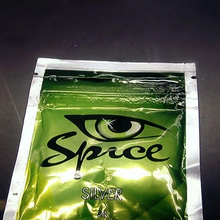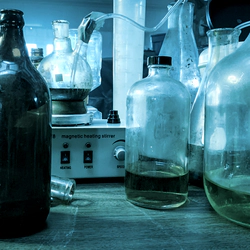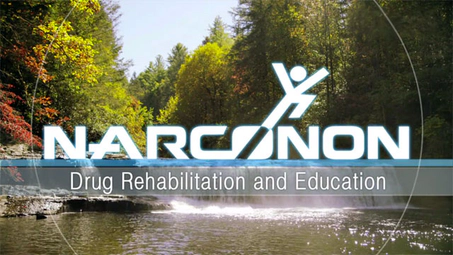DRUGS: WHAT YOU
NEED TO KNOW Booklet

Signs and Symptoms of Synthetic Drug Addiction

Because there are many different categories of synthetic drugs, there are also many different signs of addiction. The short story of synthetic drug abuse is that it is both intensely dangerous and addictive.
Synthetic drugs rose to public awareness after bizarre incidents were reported by news services, each one of which traced back to synthetic drug use. In one such incident, a man decided to break into jail to visit friends but became entangled in the razor wire atop the jail’s fence. It was determined that he had used the synthetic drug flakka before his attempted jailbreak.1
That was just the first of many bizarre incidents in which individuals either lost control of their actions, became severely ill, lost their lives or harmed others after consuming synthetic drugs.
Types of Synthetic Drugs

Courtesy of DEA.gov
Synthetic cannabinoids: Drugs advertised as having a similar effect to marijuana. Often called Spice. Sold as herbal incense, potpourri.
Synthetic cathinones: Drugs similar in chemistry and effect to the plant khat that is often abused in Eastern African countries. Often referred to as bath salts though there are dozens of different drugs in this category. Includes MDPV and mephedrone.3
Piperazines: Stimulants that may be sold as herbal products. Includes BZP and TMFPP.
Phenethylamines: Strong stimulants with hallucinogenic effects. Includes MDMA/Ecstasy, Bromo-DragonFLY and Smiles.
Tryptamines: Hallucinogenic drugs with an action similar to that of hallucinogenic mushrooms.
Synthetic cocaine: Chemically similar to cocaine. Includes the drug dimethocaine.
Ketamine: Dissociative drug used in veterinary medicine as an anesthetic.
Why There Are So Many Synthetic Drugs
Illicit chemists discovered that they could manufacture, ship and sell these formulas as “legal highs” if there were no laws specifically outlawing particular formulas. Legislators naturally tried to play catch-up by outlawing dangerous substances as quickly as possible. As one formula was outlawed, chemists would change the molecules slightly until they had a different formula that didn’t violate the law. They would continue making and distributing this new drug until the law caught up with them again.
Until the laws were changed, drug dealers could—and did—advertise these drugs as “legal highs.” Gullible drug seekers could be conned into thinking these substances were not harmful, since they were “legal.”
There is yet another reason the use of these drugs spread so far and wide. In the early days of synthetic drugs, there were no drug tests to detect their use. Many people who thought they might be drug tested in their workplace began to experiment with these drugs. Thus they gained widespread popularity.
Drugs? Or Just Toxic Chemicals?

Really, it’s hardly accurate to call these substances drugs. They are simply chemicals formulated in clandestine labs by unreliable, criminal parties. It’s no wonder that some people get sick and others die.
In multiple cities, dozens of people have been hospitalized all on the same day when bad batches of synthetic drugs were distributed. First responders have been called to deal with large groups of people who are all manifesting violent behavior, seizures or altered levels of consciousness. There’s no predicting the toxicity or composition of any drugs sold by dealers of synthetics.
Signs of Synthetic Drug Addiction
When people consume these drugs, they are hoping for some euphoria, relaxation, and perhaps changed sensory perceptions. But in many cases, they get much more than they bargained for with these unpredictable chemicals. Here are just a few of the downsides of addiction to these drugs.
Synthetic cannabinoids: Agitation, confusion, dizziness, nausea, chest pain, paranoid delusions, hallucinations, psychotic episodes.
Synthetic cathinones: Agitation, nosebleeds, hostility, nausea, irritability, seizures, chest pains, panic attacks, paranoia, violence, suicide.
Piperazines: Stomach pains, confusion, fatigue, fear of losing control, panic attacks, sensitivity to light and noise.
Phenethylamines: Increased heart rate, overheating, paranoia, panic attacks, hallucinations, psychotic episodes.
Tryptamines: Hallucinatory state with distortions of sight, sound and time, amnesia, panic attacks, anxiety, intense muscle tension, nausea, confusion and vomiting.
Synthetic cocaine: Increased blood pressure and heart rate, anxiety, temporary psychosis.
Ketamine: Disconnection from one’s identity or thoughts, hallucinations.
According to the DEA, the most commonly encountered synthetic drugs are synthetic cannabinoids and synthetic cathinones.4
Behavioral and Emotional Signs of Synthetic Drug Addiction

When a person is affected by these drugs, their behavior may be completely erratic and irrational. There have been many incidents of violence associated with the use of these drugs. The user may be paranoid and fear that the neighbors or people living in the walls want to hurt them. This kind of terror can fuel violence or suicide. Parents have killed their children and then themselves after using these drugs.
As an example, after using a synthetic cathinone, an Army medic killed himself and his wife and authorities later found their 5 year old son dead, presumably killed by one of his parents. This is just one of many tragic events that can be attributed to synthetic drug use.5
There is no limit to the irrational alterations of behavior and emotions that can occur after these drugs are consumed.
The Long-Term Physical Damage of Synthetic Drug Addiction
The physical damage of synthetic drugs can be intense and life-threatening.
Synthetic cannabinoids: Heart attack, organ failure, stroke, coma, seizures.
Synthetic cathinones: Liver failure, kidney failure, self-destruction, muscle breakdown.
Piperazines: Grand mal seizures.
Phenethylamines: Death from overheating, liver failure, kidney failure, blood vessel restriction resulting in amputations.
Tryptamines: Muscle tension to the point of muscle tissue breakdown, organ breakdown, cardiac arrhythmia and seizures.
Ketamine: Bladder damage or destruction requiring surgical removal.
Anyone considering using any of these drugs should realize that any pill, capsule or baggie they are sold may not contain the drug they think they are buying. It could contain a deadly chemical. There are no controls among the criminal elements designing, manufacturing and selling these drugs. The risks of consuming synthetic drugs are enormous.
The Long-Term Emotional and Mental Damage of Synthetic Drug Addiction
Nearly all of these drugs are addictive, either psychologically, physically or both. The use of synthetic drugs is also frequently associated with severe terror, paranoia, trauma, hospitalizations, law enforcement interactions and arrests, amnesia and many other negative experiences that can have long-lasting effects on a person.
One of the problematic long-term effects of some of these drugs is called hallucinogen-persisting perception disorder (HPPD), which is sometimes referred to as flashbacks. These terms refer to a recurrence of psychological effects such as distortions of color, time, space or size or visual hallucinations that occur long after the drug has worn off. In some cases, these effects can last for years after the drugs are no longer taken.6
Synthetic Drug Overdoses
The exact symptoms of an overdose will vary by which drug was taken. But as you can see above, overdoses of synthetic drugs are often fatal, with deaths resulting from high fevers, organ breakdown or cardiac arrest.
Withdrawal from Synthetic Drugs
Withdrawal from some of these drugs can be severely unpleasant. Symptoms can include cravings, headache, severe anxiety, insomnia, nausea and vomiting and loss of appetite. More serious symptoms may also occur, such as seizures, chest pain and palpitations.
Preventative actions should be taken to keep youth or young adults from ever experimenting with these drugs. And if it is discovered that someone has already started taking synthetic drugs, an intervention to stop them could save their life. There are few drugs with more dangerous, unpredictable effects than synthetic drugs.
Of course, if they can’t stop once they see the danger, then they are addicted. Professional support should be found to help them recover a sober, healthy future at the first moment possible.
Sources:
-
CBS Miami. “Deputies: Man High On Flakka Tries To Break Into Florida Jail.” CBS, 2015. CBS Article ↩︎
-
EMCDDA. “Synthetic cannabinoids in Europe.” EMCDDA, 2017. EMCDDA Publication (PDF) ↩︎
-
DEA. “Drugs of Abuse.” DEA, 2020. DEA Publication (PDF) ↩︎
-
DEA. “About synthetic drugs.” DEA. DEA Article ↩︎
-
Seattle Times. “Fort Lewis soldier who killed wife, self had taken synthetic ‘bath salts’ drug.” Seattle Times, 2011. Seattle Times Article ↩︎
-
NLM. “The ‘Endless Trip’ among the NPS Users.” NLM, 2017. NLM Article ↩︎


 ®
®
